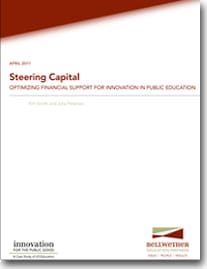 Innovation is a buzzword in many ed-reform
circles nowadays—with its presumed capacity to alter, upend, and replace
familiar systems that aren’t working well. To disrupt the status quo requires
cold, hard cash placed in the right hands, however. Bellwether Education’s new report
articulates the financial barriers to educational innovation, focusing on the “irrational,
idiosyncratic” world of education philanthropy; public policies that crowd out
entrepreneurs; and an overall shortage of investment in R&D and technology
in the education world. Offering alternative perspectives and approaches, the
authors look at trends in other sectors and analyze the key elements of
effective social-capital markets. Successes seem to hinge on public-, private-,
and philanthropic-sector collaboration, particularly in creating diverse
sources of investment capital, focusing on metrics and evidence instead of
compliance, and providing a healthy dose of transparent, useful data. Bellwether’s
offering has some affinities with a
recent paper by Kristi Kimball and Malka Kopell in the Stanford Social Innovation Review, which argues that foundations
should fund a broader portfolio of solutions to social problems and engage in
less micromanagement of the projects they support. You’ll find no arguments
from us against this kind of “tight-loose” approach to education philanthropy.
Innovation is a buzzword in many ed-reform
circles nowadays—with its presumed capacity to alter, upend, and replace
familiar systems that aren’t working well. To disrupt the status quo requires
cold, hard cash placed in the right hands, however. Bellwether Education’s new report
articulates the financial barriers to educational innovation, focusing on the “irrational,
idiosyncratic” world of education philanthropy; public policies that crowd out
entrepreneurs; and an overall shortage of investment in R&D and technology
in the education world. Offering alternative perspectives and approaches, the
authors look at trends in other sectors and analyze the key elements of
effective social-capital markets. Successes seem to hinge on public-, private-,
and philanthropic-sector collaboration, particularly in creating diverse
sources of investment capital, focusing on metrics and evidence instead of
compliance, and providing a healthy dose of transparent, useful data. Bellwether’s
offering has some affinities with a
recent paper by Kristi Kimball and Malka Kopell in the Stanford Social Innovation Review, which argues that foundations
should fund a broader portfolio of solutions to social problems and engage in
less micromanagement of the projects they support. You’ll find no arguments
from us against this kind of “tight-loose” approach to education philanthropy.
|
Kim Smith and Julie Petersen, “Steering Capital: Optimizing Financial Support for Innovation in Public Education,” (Washington, D.C.: Bellwether Education Partners, April 2011). |
